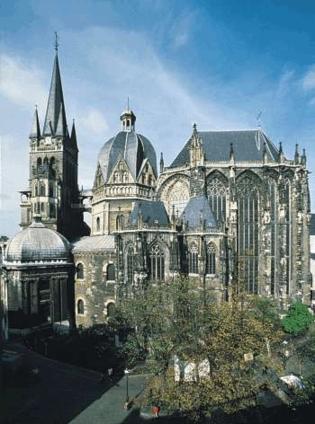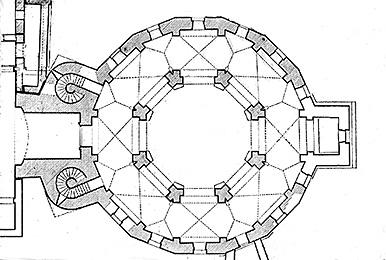
History
Aachen Cathedral, also known as the Imperial Cathedral, is the oldest cathedral in northern Europe, begun by Charlemagne, the first Holy Roman Emperor, around 792. He constructed the Palatine Chapel, along with the rest of his palace. The chapel was designed by Odo of Metz, who based it on the church of San Vitale in Ravenna, Italy. In 805, Pope Leo III consecrated the chapel in honor of the Virgin Mary. After Charlemagne died in 814, he was buried in a vault in the cathedral. In 1000, Otto III had the vault opened, and according to Otto of Lomello, one of Otto III's courtiers, Charlemagne's body had not rotted; in fact, his fingernails had grown enough to project out of his gloves.. He was wearing a golden crown and held a scepter. A canopy of limestone and marble had been built above him. A strong smell emanated from the tomb, and Otto III had the tip of Charlemagne's nose, the only part of him to rot, replaced with gold, and took a tooth from his mouth.
In 1165, Frederick I Barbarossa entered the vault and placed Charlemagne's remains in a sarcophagus of Parian marble, said to have been used for Augustus Caesar, the first Roman Emperor. That same year, at Barbarossa's request, Charlemagne was canonized as a saint. In 1168, he placed a bronze chandelier in Charlemagne's tomb. In 1215, Frederick II had Charlemagne placed in a gold and silver casket. Sometime in the 1220s and 1230s, the Shrine of St. Mary was built. It contains the Virgin Mary's cloak, Christ's swaddling clothes, the cloth John the Baptist's head lay on after his beheading, and Christ's loincloth. Every seven years since 1349, the relics are taken out and put on display during the Great Aachen Pilgrimage. In 1414, a two-part Capella vitrea (Latin for "glass chapel") was built as a choir hall in order to sustain the flow of pilgrims. Several smaller chapels and a vestibule were also added in the 1400s, creating the modern Aachen Cathedral. In 1978, Aachen Cathedral became one of the first 12 UNESCO World Heritage Sites, one of the first 3 European sites, and the first German site. From 1986 to 2006, restoration work was carried out on the dome of the cathedral.

Architecture
The Palatine Chapel was built in a Pre-Romanesque style, although it derives part of its plan and decoration from the Basilica of San Vitale in Ravenna, Italy. It consists of a sixteen-sided ambulatory with an overhead gallery encircling the octagonal dome in the center of the chapel. The bronze-work is of high quality, especially the doors and interior railings. The doors are decorated with lion heads and railings with Corinthian columns and acanthus scrolls. The dome was originally decorated in frescoes but has since been redecorated in mosaics. These were replaced in the 19th century after a fire, although the reproductions do not have the same stylistic qualities. The 24 elders of the Apocalypse are depicted standing around the base of the dome. Above the main altar and facing the throne of Charlemagne is a depiction of Christ in Majesty, a common depiction of Christ enthroned as ruler of the world with various sacred figures surrounding him.